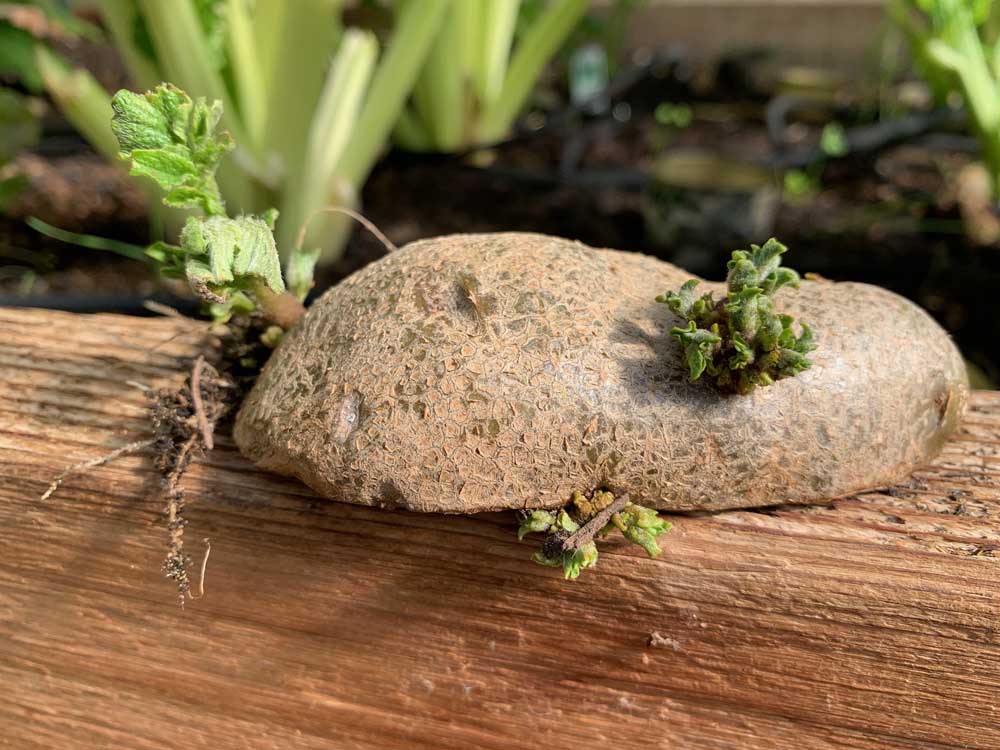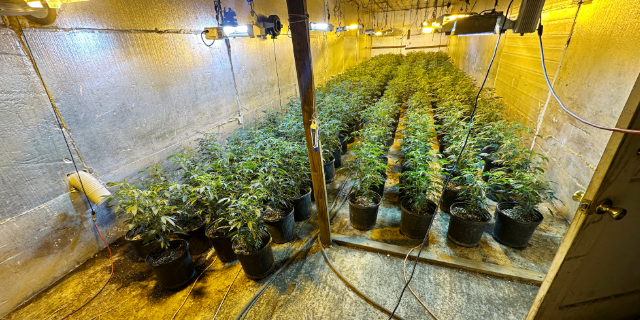GARDEN PLOTS: Keep one eye toward the future with a second crop of potatoes
Published 6:00 am Wednesday, August 2, 2023

- A sprouted piece of potato makes a good seed potato for a fall crop of spuds.
“But I must plant, don’t you see? I must continue to believe that things will grow. Spring comes, regardless of the Luftwaffe. Or whether I live or die.”
Trending
— Vita Sackville-West to Virginia Woolf in Stephanie Barron’s “The White Garden: A Novel of Virginia Woolf,” 2009
Reading garden-related novels is a superb way to garden in spirit when it’s too hot outside to garden in the flesh, although I admit “The White Garden” was the first book I pulled last fall from the pile of garden-related books I’d collected to read and write about for 2023. I was already familiar with Stephanie Barron (pen name for Francine Matthews) because I’d read a couple of her novels featuring Jane Austen as an amateur sleuth.
This part-historical, part-contemporary novel is about a landscape designer, Jo Bellamy, who visits Vita Sackville-West’s famous White Garden at Sissinghurst Castle for a client and uncovers a mystery about the death of Virginia Woolf that occurred 60 years before. She also discovers her grandfather’s role in the events that took place at Sissinghurst, a role that eventually led him to take his own life.
Trending
One of my favorite scenes in the book comes from Virginia Woolf’s journal, which Jo uncovers in a dusty storeroom. The entry dated March 29, 1941, describes a conversation between the two friends while walking after dinner in Vita’s garden. It’s at the height of Nazi Germany’s “Blitzkrieg” in England and aerial-launched bombs have burned her neighbor’s fields in Kent, yet Vita is excited when Virginia suggests planting a garden with only white flowers: lilium regale, white clematis, white lavender, white agapanthus, white double primroses, white anemones …
“They’d rise in the dark like fairy lamps, lighting your way to bed,” Virginia tells Vita. She’s perfectly aware that planting such a garden during the war is impossible, “but the idea of all this whiteness was vital to her — a cleansing impulse, a need for clarity. Light in the darkness.”
Perhaps so, but I believe Vita’s enthusiasm for planting, despite the war, is an example of the gardener’s habit of keeping one eye on the future, setting out bulbs in the fall and finding comfort and hope in daffodils emerging next spring. It reminds me of the Indian proverb that says, “The one who plants trees, knowing that he will never sit in their shade, has at least started to understand the meaning of life.”
That’s why right now I’m planting potatoes. Surely not as exciting as planting a forest of trees or an all-white flower garden, but sowing seed potatoes in the heat of summer for fall harvests is my humble way of keeping one eye on the future, even if it’s only until Thanksgiving and the heap of mashed potatoes I’m anticipating on my dinner plate.
It had not occurred to me to plant a second cropping of potatoes until I experimented with using pieces of potato to trap pill bugs and slugs. Other than a few bites taken out of the potatoes, these pests seem to be more attracted to the beer traps I also set around my leafy greens; however, several of the potato pieces with “eyes” have sprouted and some have already grown roots.
Quite fortuitously, I recently received an email about growing potatoes year-round from Territorial Seed Company based in Cottage Grove. Potatoes can be sown in the ground or in containers, so I’ve decided to give both methods a try. The rooted potatoes I’m leaving in the soil in my raised beds after mounding soil and compost on top of them, whereas I planted four sprouted potatoes in a 10-gallon container with a mixture of potting soil, compost and bone meal. I filled the container halfway, placed the potatoes sprout-up in the soil, and then finished filling the container with the planting medium.
Now all I need do is keep the soil moist in the raised beds and container, adding a balanced organic fertilizer every two weeks while watering to spur late-summer growth. Potatoes mature in approximately 90-100 days, so I’m expecting them to be ready right around Turkey Day. In fact, potatoes can be left in the ground for harvesting during winter as long as they are protected from frost.
About two weeks before they’re ready to harvest, foliage on the potato plants will begin to lose their bright green color, lean over and feel dry to the touch. Another indication that your potatoes are ready to harvest is when flower buds begin to appear. Either way, it’s time to stop watering and fertilizing so the tubers toughen up before harvesting. Keep in mind that the size of the potato doesn’t necessarily indicate its maturity — some that are ready to eat will be smaller than the potatoes sold in grocery stores.
Before I leave the topic of keeping one eye toward the future, I have to mention another book I’m reading called “What We Owe the Future” (2022). According to author William MacAskill, if human beings are to survive at least as long as the typical animal species of one million years, or even beyond that, we must shift our thinking to what he calls longtermism. Such a perspective, he argues, is the moral imperative of our times to ensure a future for the generations that follow us.
I think Vita Sackville-West would have understood the concept of longtermism. I’m not sure that planting a fall crop of potatoes really counts as longtermism, but it’s a step in the right direction.









